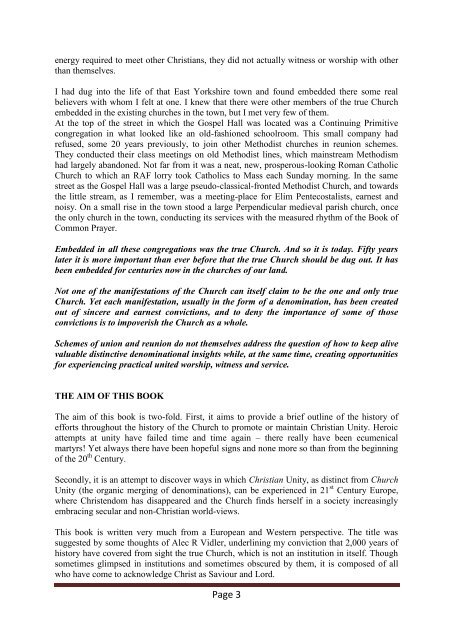Digging Out the Embedded Church - The Maranatha Community
Digging Out the Embedded Church - The Maranatha Community
Digging Out the Embedded Church - The Maranatha Community
You also want an ePaper? Increase the reach of your titles
YUMPU automatically turns print PDFs into web optimized ePapers that Google loves.
energy required to meet o<strong>the</strong>r Christians, <strong>the</strong>y did not actually witness or worship with o<strong>the</strong>r<br />
than <strong>the</strong>mselves.<br />
I had dug into <strong>the</strong> life of that East Yorkshire town and found embedded <strong>the</strong>re some real<br />
believers with whom I felt at one. I knew that <strong>the</strong>re were o<strong>the</strong>r members of <strong>the</strong> true <strong>Church</strong><br />
embedded in <strong>the</strong> existing churches in <strong>the</strong> town, but I met very few of <strong>the</strong>m.<br />
At <strong>the</strong> top of <strong>the</strong> street in which <strong>the</strong> Gospel Hall was located was a Continuing Primitive<br />
congregation in what looked like an old-fashioned schoolroom. This small company had<br />
refused, some 20 years previously, to join o<strong>the</strong>r Methodist churches in reunion schemes.<br />
<strong>The</strong>y conducted <strong>the</strong>ir class meetings on old Methodist lines, which mainstream Methodism<br />
had largely abandoned. Not far from it was a neat, new, prosperous-looking Roman Catholic<br />
<strong>Church</strong> to which an RAF lorry took Catholics to Mass each Sunday morning. In <strong>the</strong> same<br />
street as <strong>the</strong> Gospel Hall was a large pseudo-classical-fronted Methodist <strong>Church</strong>, and towards<br />
<strong>the</strong> little stream, as I remember, was a meeting-place for Elim Pentecostalists, earnest and<br />
noisy. On a small rise in <strong>the</strong> town stood a large Perpendicular medieval parish church, once<br />
<strong>the</strong> only church in <strong>the</strong> town, conducting its services with <strong>the</strong> measured rhythm of <strong>the</strong> Book of<br />
Common Prayer.<br />
<strong>Embedded</strong> in all <strong>the</strong>se congregations was <strong>the</strong> true <strong>Church</strong>. And so it is today. Fifty years<br />
later it is more important than ever before that <strong>the</strong> true <strong>Church</strong> should be dug out. It has<br />
been embedded for centuries now in <strong>the</strong> churches of our land.<br />
Not one of <strong>the</strong> manifestations of <strong>the</strong> <strong>Church</strong> can itself claim to be <strong>the</strong> one and only true<br />
<strong>Church</strong>. Yet each manifestation, usually in <strong>the</strong> form of a denomination, has been created<br />
out of sincere and earnest convictions, and to deny <strong>the</strong> importance of some of those<br />
convictions is to impoverish <strong>the</strong> <strong>Church</strong> as a whole.<br />
Schemes of union and reunion do not <strong>the</strong>mselves address <strong>the</strong> question of how to keep alive<br />
valuable distinctive denominational insights while, at <strong>the</strong> same time, creating opportunities<br />
for experiencing practical united worship, witness and service.<br />
THE AIM OF THIS BOOK<br />
<strong>The</strong> aim of this book is two-fold. First, it aims to provide a brief outline of <strong>the</strong> history of<br />
efforts throughout <strong>the</strong> history of <strong>the</strong> <strong>Church</strong> to promote or maintain Christian Unity. Heroic<br />
attempts at unity have failed time and time again – <strong>the</strong>re really have been ecumenical<br />
martyrs! Yet always <strong>the</strong>re have been hopeful signs and none more so than from <strong>the</strong> beginning<br />
of <strong>the</strong> 20 th Century.<br />
Secondly, it is an attempt to discover ways in which Christian Unity, as distinct from <strong>Church</strong><br />
Unity (<strong>the</strong> organic merging of denominations), can be experienced in 21 st Century Europe,<br />
where Christendom has disappeared and <strong>the</strong> <strong>Church</strong> finds herself in a society increasingly<br />
embracing secular and non-Christian world-views.<br />
This book is written very much from a European and Western perspective. <strong>The</strong> title was<br />
suggested by some thoughts of Alec R Vidler, underlining my conviction that 2,000 years of<br />
history have covered from sight <strong>the</strong> true <strong>Church</strong>, which is not an institution in itself. Though<br />
sometimes glimpsed in institutions and sometimes obscured by <strong>the</strong>m, it is composed of all<br />
who have come to acknowledge Christ as Saviour and Lord.<br />
Page 3








